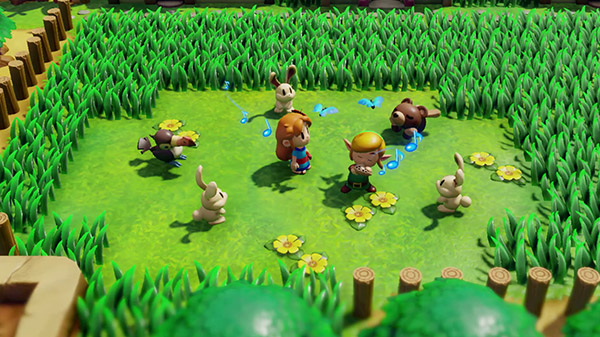Komatsu
Member


After the events of A Link to the Past, the hero Link travels by ship to other countries to train for further threats. A storm destroys his boat at sea, and he washes ashore on Koholint Island, where he is taken to the house of Tarin by his daughter Marin. She is fascinated by Link and the outside world, and tells Link wishfully that, if she were a seagull, she would leave and travel across the sea. After Link recovers his sword, a mysterious owl tells him that he must wake the Wind Fish, Koholint's guardian, in order to return home. The Wind Fish lies dreaming in a giant egg on top of Mt. Tamaranch, and can only be awakened by the eight Instruments of the Sirens.
Link proceeds to explore a series of dungeons in order to recover the eight instruments. During his search for the sixth instrument, Link goes to the Ancient Ruins. There he finds a mural that details the reality of the island: that it is merely a dream world created by the Wind Fish. After this revelation, the owl tells Link that this is only a rumor, and only the Wind Fish knows for certain whether it is true. Throughout Koholint Island, nightmare creatures attempt to obstruct Link's quest for the instruments, as they wish to rule the Wind Fish's dreamworld.
After collecting all eight instruments from the eight dungeons across Koholint, Link climbs to the top of Mt. Tamaranch and plays the Ballad of the Wind Fish. This breaks open the egg in which the Wind Fish sleeps; Link enters and confronts the last evil being, a Nightmare that takes the form of Ganon and other enemies from Link's past.[24] Its final transformation is "DethI", a cyclopean, dual-tentacled Shadow. After Link defeats DethI, the owl reveals itself to be the Wind Fish's spirit, and the Wind Fish confirms that Koholint is all his dream. When Link plays the Ballad of the Wind Fish again, he and the Wind Fish awaken; Koholint Island and all its inhabitants slowly disappear. Link finds himself lying on driftwood in the middle of the ocean, with the Wind Fish flying overhead. If the player did not lose any lives during the game, Marin is shown flying after the ending credits finish. [FROM THE WIKI]


The original Link's Awakening began as a small proof-of-concept programmer Kazuaki Morita created in one the early Game Boy development kits, as he wanted to experiment with the new console's capabilities. It soon became an "after-hours" diversion for a number of other Nintendo EAD developers, who would work on the game after clocking out. Once a Link to the Past was released and its director Takashi Tezuka asked to be allowed to create a handheld Zelda game, he assembled the programmers who had been working on Morita's side project - as well as Morita himself - and got them to work on what would become the original game for the Game Boy platform.

Link's Awakening has been previously remastered for the Game Boy Color in 1998, but this time Nintendo EAD decided to go with a "retro-modern" style that evokes plastic toys, in an aesthetic very different from the pseudo-cel-shaded Wind Waker-inspired visuals of other mobile Zelda titles. Eiji Aonuma, director of Majora's Mask and the Zelda series producer, likened this art style to a "diorama". Another change is that the original Camera Shop has been replaced with a house where the play can design his or her own dungeons. Additionally, the decision was made to retain some of the dungeons retainwith 1:1 ratio of the original game, as many of the puzzles and/or action pieces would not work with a 16:9 aspect ratio.










The Legend of Zelda: Link's Awakening review thread
https://www.metacritic.com/game/switch/the-legend-of-zelda-links-awakening https://opencritic.com/game/7871/the-legend-of-zelda-links-awakening IGN: 9.4/10 My most succinct recommendation for the 2019 remake of The Legend of Zelda: Link’s Awakening would be this: a couple of weeks ago...
Last edited:




